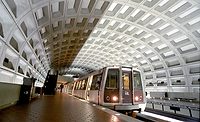Security on Mass Transit to Improve Service and Reduce Crime

Cameras are positioned at stations throughout the San Diego transit system. Photo courtesy San Diego MTS

There is a combination of security technology and law enforcement partnerships with the San Diego Metropolitan Transit System. Photo courtesy San Diego MTS


Images can be easily shared with local law enforcement when needed. Photo courtesy Denver RTD

The Denver Regional Transportation District monitors its security video as well as receives calls from commuters. Photo courtesy Denver RTD

Transit cameras are designed to be less intrusive at the Massachusetts Bay Transportation Authority. Photo courtesy Genetec

Amber alerts and other security messages can be displayed at transit stations. Photo courtesy Peerless AV







For Chanda Litten, light rail in Sacramento is the way to get around although she was sometimes faced with characters who made her uneasy. “It’s really dark, and you see some undesirables,” she reported to a local TV station. “It doesn’t happen often, but when it does it can be very scary.” Norm Leong, the head of Regional Transit Police in Sacramento, California, plans to improve the system through use of more video and patrol coordination with local police.
Chupeta was even less lucky on his transit ride in São Paulo, Brazil, when the notorious drug kingpin was arrested after security video integrated with facial recognition compared him against images stored on various databases of the metropolitan police, prosecutors and Interpol.
Litten and Chupeta are among a lot of folks wanting a safe transit ride or getting caught thanks to better transit security. In the U.S. alone, people took 10.8 billion trips on public transportation in 2014, which is the highest annual public transit ridership in 58 years, according to the American Public Transportation Association (APTA). Says Phillip Washington, APTA chair and CEO and general manager of the Regional Transportation District in Denver, “Some public transit systems experienced all-time record high ridership last year. This record ridership didn’t just happen in large cities. It also happened in small and medium size communities.”
A virtual bus tour of some of the country’s leading transit systems shows how security is installing more with an ever-squeezed budget, intelligently transitioning from analog to IP networked video, integrating security technology into transit operations and maintenance, developing innovative on-board video and audio systems with real-time on-demand central monitoring while working even more closely with local city and law enforcement officials. Some sophisticated video systems can even track a person as he or she moves through stations, buses or light rail by picturing the person or just entering a description to create a traceable avatar.
Getting Everyone Involved in Security
Some transit agencies even enroll their passengers into a “See Something, Say Something” program which encourages sending texts and event images via smartphone to security to report or show non-emergency concerns.
First stop on the transit security tour is Boston and the Massachusetts Bay Transportation Authority or MBTA. Its Tremont Street Subway in Boston’s subway is the oldest subway tunnel in North America, opened on September 1897. But MBTA is in many ways ahead of the curve when it comes to security technology.
Handling the advances is Randy Clarke, senior director of security and emergency management at MBTA, with responsibilities over design and installation of all security systems including video surveillance, access control, bollards, gates, chemical sensors and tunnel intrusion detection. He takes a holistic view of security and how it all works with the operations side, too.
Together with his integrator Joseph Lynch, Jr., CEO at Minuteman Security Technologies, Clarke developed an on-board system that includes a Genetec Omnicast engine with added mobile capabilities, onboard Axiomtek i7 fanless network video recorders, Ethernet switches from Moxa, Teldat for Wi-Fi and 4G LTE cellular as well as Panasonic cameras. “It’s all about improved image quality with lower bandwidth,” says Lynch. “They wanted mobility and better IP video as well as management of alarm events in real-time.”
“Depending on the bus, we have six camera configurations,” adds Clarke. Now there is access to live video from the operations control center via 4G LTE, automatic offloading of video to long-term archiving upon buses reaching the terminals via Wi-Fi, police officer data access to nearby bus systems via cruiser mobile terminals and some additional applications.
Automatic Downloading of Video
A customized video requester tool has simplified the retrieval of video on-board buses for long-term archiving. Operators send a request to the Omnicast system for a specific instance of video. Once the bus is back at the terminal, the system will automatically offload the video to the central archiver through a wireless network, and automatically email a notification to the end user once the transfer is complete. This automatic video offloading was enabled by a feature called video trickling, which helps minimize bandwidth consumption.
Each new bus is now outfitted with two 360-degree cameras, one interior fixed high-definition camera, and three external 720p high-definition cameras, all from Panasonic.
Next stop on the transit tour: Denver and its Regional Transportation District or Denver RTD, a system that covers eight counties and 44 cities with 3,000 employees.
John Tarbert, transit police chief at Denver RTD, is bringing new technology onboard, stressing IP high definition video with network video recorders in the field on buses and light rail as well video at commuter structures. “We conducted 9,124 investigations in one year and see video as mitigating liability as well as being a deterrent. We publicize [security video] all the time. If emergency phones are activated, for example, cameras turn to that area.”
Denver also has a TransitWatch app which allows riders to send text, photos and audio, chat with public safety techs who are 911 certified, and it uses GPS to pinpoint locations. “Last year we had 1,400 text messages and out of those, 900 resulted in arrests at the next stop on either the bus or train,” Tarbert says.
“We’re evolving and taking it to the next level,” comments Bob Grado, transit police commander, Denver RTD Transit Police Division. “We are maximizing use of security video” and using it for operations, too. “We can check if contractors are sweeping the snow. It minimizes claims [against the system] when some may over-exaggerate an injury or minor incident. The cameras fight internal and external crime as well as graffiti.”
Making Use of 4K Cameras
Tarbert and Grado are strategically moving to high definition – at least 1.3 megapixel and more recently 4K 360 degree 9-megapixel cameras with the help of Panasonic. Says Grado, “We can do more for less with 4K. Its low profile also works with low ceilings of commuter parking areas, for example. They can handle almost total darkness with the low light technology. Fewer cameras are needed to cover more area.”
According to Steve Cruz, strategic transit solutions manager with Panasonic, video is a matter of safety, while reducing criminal activity and minimizing liability. Video systems gather more information with accuracy and time savings for enterprises. Cruz works with the Denver executives developing the video system, which includes Nice Systems [Nice Americas] technology. He says that Denver is the first transit agency in the U.S. to use 4K.
“Having high definition and the color pictures helps us identify a person’s clothing and then we get a more detailed picture of their face,” Grado says. Tarbert adds, “If they can see that we can see them do something wrong, it makes them not want to do something wrong on our property.”
There also is an investigative aspect to such systems, with many police departments seeking out transit video for incidents that may or may not be transit related. In Denver, for example, transit video produced evidence in the case of Earl Moore, who bombed Southwest Plaza Mall in Littleton, Colo. Law enforcement used Denver RTD security footage to identify him and tie him to the bombing. “We can see a lot more detail,” Tarbert says. “And if a crime did occur and the suspect gets away, we have a very clear picture to disseminate to the other law enforcement agencies in the district.”
According to Moti Shabtai, Vice President Security, Nice Americas, situational management can connect everything into a single platform, and then turn that information into operational intelligence. When using transit security technology, he says, security leaders should anticipate what may happen, be ready for the risk and mitigate it. Predicting possible security events is essential, and analyzing past events and practicing based on those scenarios proves valuable.
Tracking People Along Transit Use
One additional important stop on the transit tour is San Francisco. There Frank Lau, project manager with the San Francisco Municipal Transportation Agency (SFMTA), is in the clouds over his security strategies. SFMTA wanted to maximize use of security video, including buses, trains and subways. Technology throughout the SFMTA network come from a range of manufacturers, including Dedicated Micros, Axis Communications, Exacq Technologies and BRS Labs. Coverage now includes Immix Cloud from SureView Systems; it allows running applications in the cloud by creating a private cloud to deliver customized services through any Web browser or mobile device.
Like any public transit agency, we share a common challenge, says Lau. “We have different brands” of products and Immix was an eye opener. It was most open. It is very easy to use. There is a list of the cameras and it’s map based.”
A new command center – the transportation management center – was built in the heart of San Francisco to centralize the response of the security team. In this new collaborative command center, SFMTA selected Immix CC as the software platform to deliver the flexibility required to service the various needs of these teams. It provides a single interface for the different security teams in traffic and transit to access the six different cameras and video systems.
Technology and unique transit requirements are a focus for John Recesso, strategic business development manager, security systems division at Sony Electronics. He says that analytics can create a virtual fence, and end users can black out restricted areas for privacy.
Light Changes Are a Challenge
In Baltimore, for Amtrak, in Chicago and BART in San Francisco, one challenge is sunlight. According to Recesso, cameras need to adjust to changing light conditions quickly. He suggests that using wireless mesh networks and 4G LTE can help enterprises manage video on trains, buses and even law enforcement body-worn cameras.
Just south of San Francisco, a next stop is San Diego, its San Diego Metropolitan Transit System and Chief of Police Bill Burke, who uses myriad solutions including bomb sniffing dogs and tracking persons of interest as well as plains clothes officers. He is also using body cameras.
Recently, the San Diego Metropolitan Transit System and law enforcement officials from five agencies created a joint task force to enhance safety and security for San Diego’s transit system. The task force was made possible by a $1 million grant from the federal Transportation Security Grant Program through the Department of Homeland Security.
Working alongside MTS security personnel will be officers from the Sheriff’s Department, and police departments from San Diego, Chula Vista, El Cajon and La Mesa. The task force will operate as a mix of plain clothes and uniformed officers using unmarked and marked vehicles. Task force members will conduct fare inspections, look for suspicious activity and help ensure a safe environment for passengers. The goals of the security task force are:
- Enhance protection at densely populated facilities such as multi-modal transit centers.
- Further integrate law enforcement officers into MTS security and enforcements efforts.
- Improve information sharing among local law enforcement agencies and MTS security personnel.
- Provide directed patrols to enhance homeland security on public transportation.
Recent security upgrades MTS has implemented include: Enhance video systems on all trolleys and most transit stations; body cameras for code enforcement officers; a canine unit to patrol trains and respond to reports of suspicious packages and bomb threats; and “Eagle Team” – a special unit to patrol late night trains.
Coordination with Local Law Enforcement
“Having highly visible law enforcement officers will be a strong deterrent to inappropriate conduct, as well as criminal activity,” says Burke. With just months into the cooperative program, Burke is impressive with the arrangement. San Diego MTS operates 95 bus routes and three trolley lines on 53 miles of double-tracked railway. Every weekday, more than 300,000 passenger trips are taken.
Looking at things more generally, transportation security expert Larry Mays says, “Obviously the number one concern is terrorism. Preventing a catastrophic event which is intentionally aimed at harming people, disrupting commerce and/or instilling fear on the psyche of the American public is at the top of the list of all levels of government. Since 9/11, transit security has been very concerned with having another major transit event in this country. And with good reason – there are groups whose sole purpose is to instill fear and to undermine the safety and security of the American public. Europe has more exposure to this type of threat, but every day would-be attackers are attempting and getting closer with succeeding at hitting U.S. targets.”
Mays adds, “Second on the list is organized crime rings who target transit systems for purposes of smuggling, trafficking, theft of expensive goods and agency supplies. Third is the safety of travelers from slip and fall accidents and other events caused by human error.”
When it comes to buses, Mays says, “There are many more tested mobile solutions for rolling stock, such as onboard cameras, remote speed controlling and vehicle stopping technology, especially for buses. If a bus or truck has been hijacked it is possible to remotely take control of the speed controls and bring the vehicle to a controlled stop. Further, there is commercially available off-the-shelf security integration platforms that can support the fundamental designs for a robust concept of operations. The next step in hardening a transit operator’s infrastructure is the total and absolute integration of access control, cameras, intrusion, fire, burglar alarms and other types of perimeter protection into a common command center user interface.”
SIDEBAR: A Sign of the Times
Transit systems are adding sophisticated signage to their platforms to provide information to commuters on arrivals of trains but also can use the digital signs for security purposes.
Jack McKeague, general manager and vice president of sales – display division at Peerless-AV, has technology in the Washington (D.C.) Metropolitan Area Transit Authority and the Chicago Transit Authority, among others.
Designed for high-traffic areas such as airports, train stations, bus stations, parking facilities and public transportation stops, such transportation solutions are safe, secure and highly durable. Mounts and audio visual accessories stand up to demanding transportation environments. McKeague suggests that signage also compensates for light changes to aid readability, and the signs can feature cameras that work with surveillance.
SIDEBAR: Transit of Hazardous and Volatile Materials
Transit is much more than commuters. Take Intergulf Corporation, an industrial liquids management company specializing in procuring, blending, treating and processing petroleum, petrochemical coproducts and waste streams. “We have security cameras and DVRs at truck terminals and to protect large equipment and tank farms as well as barges and tug boats,” says Michael Canales, plant manager at Texas-based Intergulf Corporation. The analytics in the cameras set up a virtual fence for alerting of intruders.
There also is card access control from Honeywell (ProWatch 4.2) with badge readers and long range readers, too, says John Copeland, senior project manager, ESI Fire & Security, Inc., Intergulf’s integrator. Also there are: IP Intercom systems, gate protection, PTZ and fixed zooms, adds Robert Burleson, project coordinator, ESI Fire & Security, Inc.
Looking for a reprint of this article?
From high-res PDFs to custom plaques, order your copy today!






.jpg?height=200&t=1670387394&width=200)









